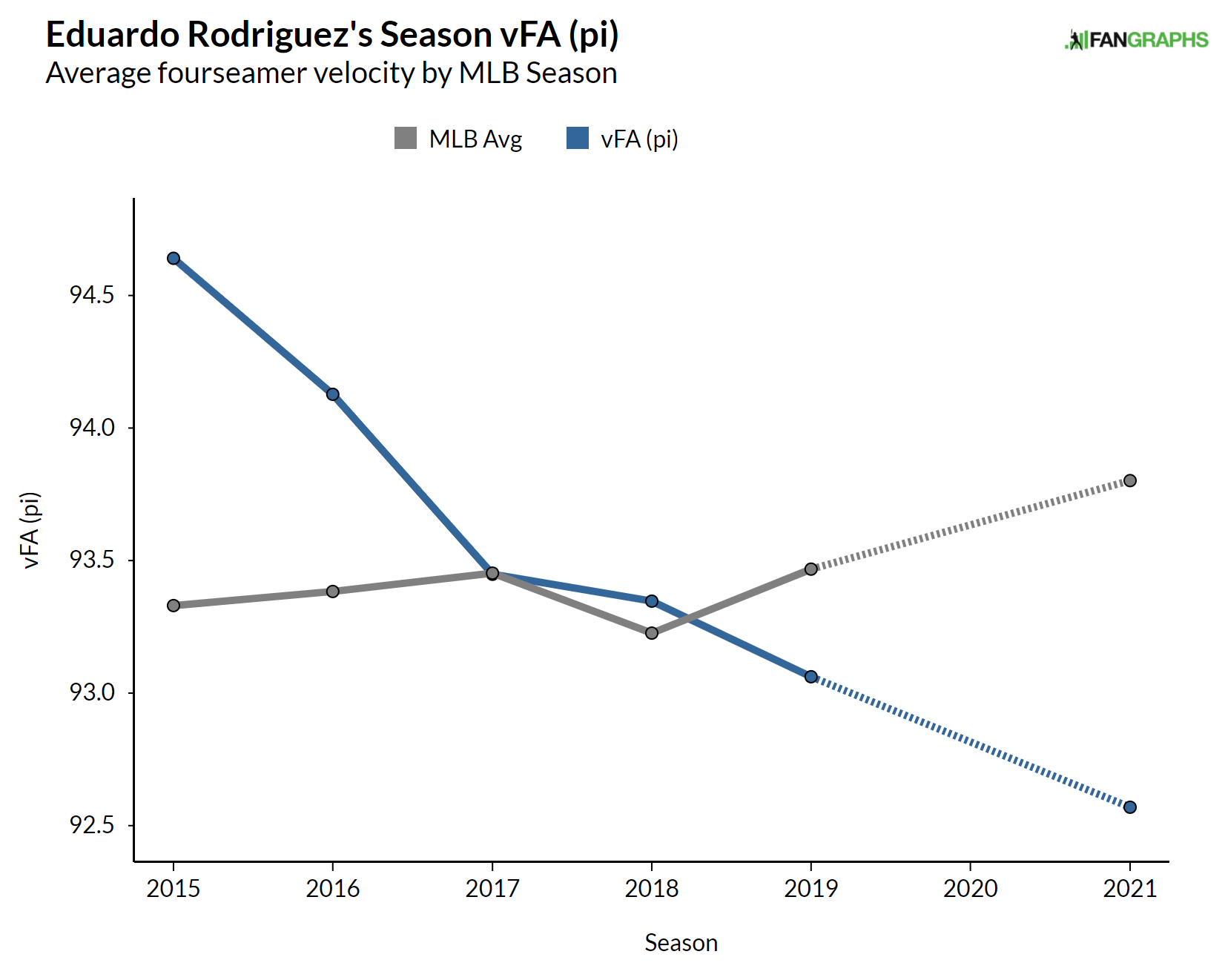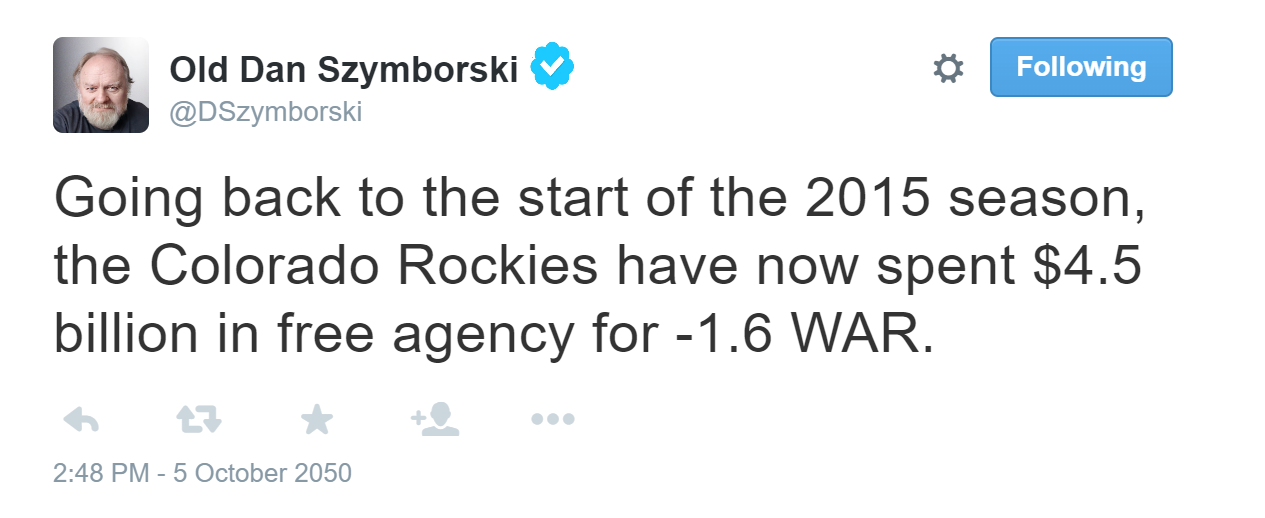Eduardo Rodriguez has been one of the vital cogs for the resurgent Red Sox. Sure, Boston’s league-leading wRC+ is the main impetus for the club’s success. But both the starting rotation and the bullpen have been in the top third of the league and Rodriguez has been one of the larger actors of the former’s placement among the league-leaders. Rodriguez has accumulated 0.4 WAR in just four starts and 23 innings of work. He sports a 3.52 ERA and 3.34 FIP despite allowing a gaudy 17.4% HR/FB. The main driver of his results? Not only is he striking out a shade more than 29% of opposing hitters (after posting marks of 24.8% and 26.4% the previous two seasons), his walk rate sits at a sparkling 2.2%. This start is already extremely impressive. But in the context of what he endured in the very recent past, I would say it’s extraordinary.
For those unfamiliar, Rodriguez missed the entire 2020 campaign. It wasn’t due to an elbow injury or shoulder soreness or forearm tightness. Rodriguez suffered myocarditis; a heart condition connected to contracting COVID-19. Speaking to Joon Lee of ESPN, Rodriguez said he could not throw pitches without feeling significant fatigue brought on by the effects of his condition. He was unable to train for three months. This meant that not only did he miss last season but he was behind the proverbial eight ball when it came to preparing for the 2021 season.
Getting back on the mound was an amazing accomplishment alone. Having one of the most dominant starts to the season among all starting pitchers is one of the most surprising developments of the young season. Rodriguez has not just picked up where he left off. He has adjusted his pitch mix and fundamentally changed the method by which he attacks hitters.
His fastball velocity is down a half a tick, despite the league average increasing by half a tick.

But that hasn’t proven to be a problem. As I alluded to, he has made major tweaks to his arsenal in 2021. In his first three major league seasons, Rodriguez leveraged his plus fastball velocity by throwing the pitch about 60% of the time. As the velocity diminished, he began to rely on the pitch less in 2018-19. Now the four-seamer is his second-most used pitch:
Rodriguez Pitch Mix 2021 vs. 2018-19
| Pitch Type |
2021 Pitch% |
2021 SwStr% |
2021 wOBA |
2018-19 Pitch% |
2018-19 SwStr% |
2018-19 wOBA |
| CH |
31.2 |
16.8 |
.262 |
21.8 |
18.7 |
.294 |
| FF |
26.8 |
18.5 |
.337 |
38.1 |
10.4 |
.358 |
| FC |
20.4 |
5.7 |
.350 |
17.8 |
7.7 |
.264 |
| SL |
9.0 |
3.2 |
.182 |
5.0 |
10.4 |
.537 |
SOURCE: Baseball Savant
His four-seam usage is down 11.3 percentage points and he is really leaning into his elite changeup, the gem of his arsenal now that he is not a flame-throwing 22-year-old. The pitch has garnered swinging strikes at a 16.8% clip, a monstrous figure given how often he throws it. It gives him a great tool to keep right-handed hitters at bay. Rodriguez, like most, favors the pitch less with the platoon advantage, where he is more egalitarian with his pitch selection. Not only have opposing hitters struggled to make contact with the changeup, but the pitch has allowed just a .262 wOBA in plate appearances where he finishes off the batters with it.
The fastball, his most used pitch against left-handers, is inducing swinging strikes at a 18.5% rate, almost double the league average for the pitch type. Rodriguez’s main two pitches have been excellent in getting hitters to swing and miss. All of the whiffs on his two main pitches are surely a vital factor in adding almost 25% to his strikeout rate. Interestingly he has struggled to see the same swinging strike gains with his other two pitches, the cutter and slider. The slider, which he only throws 9.0% of the time, has allowed just a .182 wOBA despite the lack of whiffs. Such a discrepancy is not likely to hold. The cutter has not been great in terms of either whiff rate or overall production mitigation. And the movement profile of all his pitches is stable across seasons, so the rise in strikeout rate cannot be attributed to deviations in the quality of his stuff. If you look across all counts, there does not seem to be much of a difference between how often Rodriguez gets batters to whiff:
Rodriguez SwStr% by Count
| Year |
0-0 |
0-1 |
0-2 |
1-0 |
1-1 |
1-2 |
2-0 |
2-1 |
2-2 |
3-0 |
3-1 |
3-2 |
| 2018-2019 |
8.7 |
12.2 |
13.8 |
9.6 |
15.7 |
10.7 |
14.9 |
13.1 |
10.9 |
0.0 |
14.1 |
12.8 |
| 2021 |
10.1 |
10.9 |
14.8 |
10 |
12.1 |
19 |
25.0 |
25.0 |
7.7 |
0.0 |
0.0 |
13.3 |
SOURCE: Baseball Savant
He has been mildly more successful in two-strike counts. The same is true for more hitter-friendly counts. So what has contributed to large uptick in his swinging strike rate overall? The trick is that he is avoiding these hitter-friendly counts more than ever, bridging the start of plate appearances to two-strike counts more efficiently, which buoys his swinging strike rate on all pitches.
Rodriguez Percentage of Pitches by Count
| Year |
0-0 |
0-1 |
0-2 |
1-0 |
1-1 |
1-2 |
2-0 |
2-1 |
2-2 |
3-0 |
3-1 |
3-2 |
| 2018-2019 |
24.2 |
12.6 |
6.2 |
9.1 |
10.4 |
9.7 |
3.2 |
5.7 |
9.3 |
0.8 |
2.3 |
6.5 |
| 2021 |
25.9 |
13.4 |
7.9 |
8.7 |
9.6 |
12.2 |
2.3 |
3.5 |
11.4 |
0.3 |
0.3 |
4.4 |
SOURCE: Baseball Savant
Rodriguez is facing more batters in 0-2, 1-2, and 2-2 counts (31.5% versus 25.2% in 2018-19). His first pitch strike rate is up a couple of percentage points. Batters are seeing ball three on only 5% of pitches against Rodriguez compared to 9.6% before. You cannot throw ball four without getting to ball three, so that fact that this has led to a minuscule walk rate is not surprising in the slightest.
Excising batter-friendly counts is the result of Rodriguez relentlessly attacking the strike zone. In 2018 and ’19 combined, he threw 47.4% of his pitches in the strike zone (49.8% in ’18 and just 45.8% in ’19). That figure has climbed all the way up to 56.9% in his four 2021 starts and is not unique to any count-based situation. He is filling up the zone in two strike counts to the tune of 53.7% compared to 39.5% in 2018-19 per data from Baseball Savant. When even or behind in the count, his zone rate is up to 58.3% from 49.6% in those previous couple of seasons.
He has come back and become a markedly more aggressive pitcher. So far the strategy has worked and helped him get to those precious two-strike counts, a vital step to posting a higher strikeout rate. And by living so often in the zone, hitters are forced to swing at Rodriguez’s offerings more often and rarely get into advantageous three ball counts. His swing rate against is almost six percentage points higher than in previous seasons, with the uptick in swinging strike percentage as a cherry on top. That is some tough sledding for opposing batters, if you ask me.
Eduardo Rodriguez entered 2021 with a completely revamped approach. He has made substantial adjustments to his pitch mix, throwing his signature changeup most often at the expense of his four-seamer, which is probably at least partially the result of a decline in velocity. Not only that, but the degree to which he is taking the initiative and filling up the zone is forcing hitters to swing more, often decreasing the chance they can draw the walk. All the while, he is inducing the highest swinging strike rates of his career.
If that were the end of the story, we would be excited to see what Rodriguez will do going forward, and with good reason. But we know there is much more to it than that. He has made these adjustments after missing the entire 2020 season due to complications from COVID-19. If anyone said they felt confident about what to expect from Rodriguez in 2021, they were lying. To see him back in action and as good as ever — better even — has been one of the most exciting developments of the 2021 season.

 Dan Szymborski
Dan Szymborski

